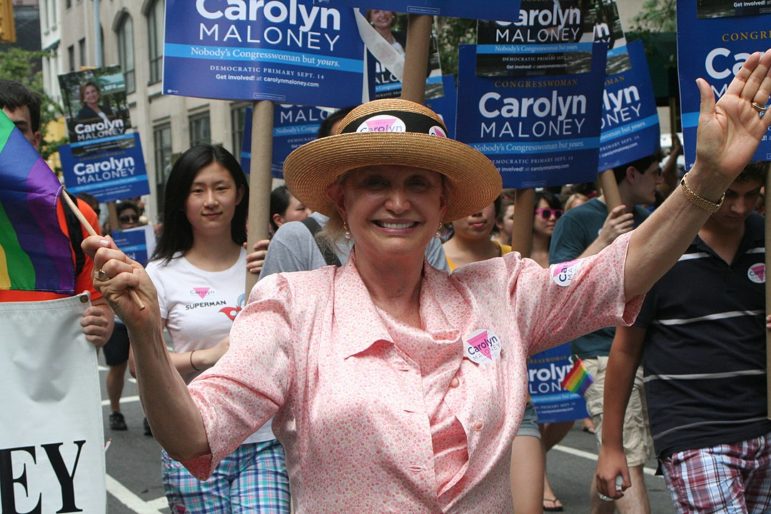There was—and continues to be—concern that delays by election boards and postal service failures could lead to mail-in ballots being omitted from the final tally.

Contrary to what President Trump alleged in Tuesday’s first presidential debate, there was never a charge or finding of fraud in Rep. Carolyn Maloney’s primary victory this summer.
Instead, there was—and continues to be—concern that delays by election boards and postal-service failures could lead to mail-in ballots being omitted from the final tally of votes.
The Maloney race triggered a lawsuit over how New York handles mail-in ballots. It was filed to address problems that cropped up in the June 23 Democratic primary for that seat and a handful of other offices.
While the primary is over, that lawsuit is still active, with plaintiffs pushing for changes to how election officials will deal with mail-in ballots in the general election on November 3. Sen. Alessandra Biaggi, a leader of election reform efforts in Albany, joined the case two weeks ago.
A tight race
In the June primary for the 12th district—which is anchored on Manhattan’s Upper East Side but includes chunks of Brooklyn and Queens—Maloney faced three challengers: Lauren Ashcraft, Peter Harrison and Suraj Patel.
Election Day results gave Maloney a slim lead over Patel. As was the case in districts all over the state, an unprecedented number of ballots were mailed in, and Maloney’s advantage grew as the tally progressed.
As elections officials counted those ballots, however, problems over postmarks emerged.
Under state law at the time, ballots without a postmark that arrived after Election Day would not be counted. But the city Board of Elections had been late mailing ballots out to voters. And local post offices had failed to postmark all the ballots it had processed.
In an event that Trump and Democratic president nominee Joe Biden seem unlikely to mimic, on July 17, all four Democratic candidates in the primary called for elections officials to loosen the standards for counting ballots, in light of the unique importance of mail-in ballots to the race and the postal issues. Their joint statement read:
“Everyone involved in this year’s primary election has faced an unprecedented situation—in more ways than one. Both the Board of Elections and the Post Office were charged with handling absentee ballots on a scale never before seen in New York’s history, and we have seen their hard-working staff doing their best to keep up with the sheer volume of ballots returned.As many are now aware, an issue with postage meant that a portion of absentee ballots were returned without postmark—invalidating them under the law. The Board has already agreed to count ballots received without a postmark before the 24th – now we are asking that they agree to count all ballots received without a postmark.
Put bluntly: A missing postmark, over which voters had no control, should not disenfranchise those voters.”
Legal fight
The same day, Patel joined with candidates for Assembly and district leader posts in a federal lawsuit against the state Board of Elections that aimed to compel local elections boards, like New York City’s, to count ballots without postmarks. (Some of the ballots examined as part of the lawsuit were invalidated for reasons other than the postmark, like a missing signature.)
In early August, the judge in the case ordered just under 1,000 ballots that had been invalidated to be counted, citing acute postal problems in Brooklyn. The new tally narrowed Maloney’s lead but did not erase it. Patel conceded defeat but protested the fact that 11,000 other ballots remained invalidated.
My Final Statement on the NY-12 Congressional Democratic Primary: pic.twitter.com/QQAKQUlXwQ
— Suraj Patel (@surajpatelnyc) August 27, 2020
After the primary, the legislature passed and Gov. Cuomo signed a law under which “absentee ballots postmarked on or before Election Day or received by the Board of Elections without a postmark on the day after the Election will be counted” and “ballots with a postmark demonstrating that they were mailed on or before Election Day will be counted if received by November 10,” according to the governor’s office.
That law, however, still depends upon there being a postmark on ballots that come in after November 4. Biaggi argued in a September 18 filing to the federal court that the Trump administration has made it perilous to rely on election mail being handled properly.
“According to media reports, since June, the president and postmaster general have dramatically reduced the capacity of the USPS by dismantling mail sorting machines, removing postal boxes, suspending overtime pay for USPS workers, and instituting a hiring freeze,” she wrote. “Additionally, the president continues to make false and disdainful public statements in what appears to be a campaign to sow public mistrust in the integrity of the USPS and mail in voting.”
Looking to November 3
The lawsuit now demands that New York’s election boards count otherwise valid absentee ballots “received by the end of the first day after the election, without regard to whether such ballots are postmarked by election day” or “received by the end of the second day after the election, so long as such ballots are not postmarked later than election day,” and also count ballots with no postmark at all.
Federal mistakes in handling COVID-19 that allowed the virus to grow into a killer pandemic are why mail-in ballots will play a major role in the 2020 general election. Trump administration changes to the postal system have heightened anxiety about whether ballots will get where they need to be on time. And if anything, the president’s repeated claims about “fraud” will be used as a pretext for efforts to invalidate mail-in ballots—exacerbating, rather than resolving, the problems that affected the 12th district primary in June.
In a tweet on Tuesday night, Patel distinguished between the president’s bluster and the real issues that surfaced in the June primary.
Let’s be clear, the issue in my race was disenfranchisement, not voter fraud. More than 1 in 5 ballots were discarded, many multiples of the final margin.
— Suraj Patel (@surajpatelnyc) September 30, 2020
We called our election a canary in the coal mine for November, we were right.
Trump lied about what happened here









